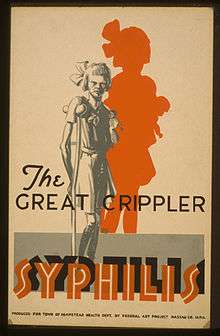La Follette-Bulwinkle Act
.svg.png) | |
| Long title | An Act to impose additional duties upon the United States Public Health Service in connection with the investigation and control of the venereal diseases. |
|---|---|
| Nicknames | Venereal Diseases Control and Prevention Act of 1938 |
| Enacted by | the 75th United States Congress |
| Effective | May 24, 1938 |
| Citations | |
| Public law | 75-540 |
| Statutes at Large | 52 Stat. 439 |
| Codification | |
| Titles amended | 42 U.S.C.: Public Health and Social Welfare |
| U.S.C. sections created | 42 U.S.C. ch. 1, subch. I §§ 25a-25e |
| Legislative history | |
| |

La Follette-Bulwinkle Act or Venereal Diseases Control and Prevention Act of 1938 sanctioned federal assistance to U.S. states establishing preventive healthcare for venereal diseases. The United States federal statute commissioned the United States Public Health Service for demonstrations, investigations, and studies as related to the control, prevention, and treatment of the transmissible diseases. The public law amended the Army Appropriations Act of 1918 appending the judicial context which created the Division of Venereal Diseases within the Bureau of the Public Health Service.[1]
The S. 3290 legislation was passed during the 75th United States Congressional session and enacted into law by the 32nd President of the United States Franklin Roosevelt on May 24, 1938.
Sections of the Act
The Title 42 Section 25 codified law was penned as five sections establishing federal rulings for the Public Health Service enforcement to control and eradicate venereal diseases in the United States as determined by the Surgeon General of the United States.
- 42 U.S.C. § 25a ~ Assistance to U.S. states
- 42 U.S.C. § 25b ~ Basis and determination of annual allotments
- 42 U.S.C. § 25c ~ Quarterly allotments
- 42 U.S.C. § 25d ~ Prescribe the rules and regulations
- 42 U.S.C. § 25e ~ Provisions not to limit or supersede existing functions
Communicable Diseases & Public Health Service Act
The 1960s sexual revolution movement prompt the United States Congress to draft amendments for the Public Health Service Act authorizing control, prevention, and vaccination assistance for communicable diseases. The United States statutes were enacted into law by the 37th President of the United States Richard Nixon and the 38th President of the United States Gerald Ford.
- Communicable Diseases Legislative Policies
See also
- Arsphenamine
- Birth control movement in the United States
- Magic bullet
- Penicillin
- Tuskegee syphilis experiment
- Venereal Disease Research Laboratory test
References
- ↑ "Army Appropriations Act of 1918 ~ P.L. 65-193" (PDF). 40 Stat. 886 ~ House Bill 12281. Legis★Works. July 9, 1918.
- ↑ "Communicable Disease Control Amendments of 1970 ~ P.L. 91-464" (PDF). 84 Stat. 988 ~ Senate Bill 2264. U.S. Government Printing Office. October 16, 1970.
- ↑ "Communicable Disease Control Amendments of 1972 ~ P.L. 92-449" (PDF). 86 Stat. 748 ~ Senate Bill 3442. U.S. Government Printing Office. September 30, 1972.
- ↑ "Disease Control Amendments of 1976 ~ P.L. 94-317" (PDF). 90 Stat. 695 ~ Senate Bill 1466. U.S. Government Printing Office. June 23, 1976.
- ↑ "S. 1466 ~ Disease Control Amendments of 1976". P.L. 94-317 ~ 90 Stat. 695. Congress.gov. April 17, 1975.
External links
- Peters, Gerhard; Woolley, John T. "Franklin D. Roosevelt: "Letter to the National Conference on Venereal Disease Control.," December 24, 1936". The American Presidency Project. University of California - Santa Barbara.
- "Federal Food, Drug, and Cosmetic Act Penicillin Amendment ~ P.L. 79-139" (PDF). 59 Stat. 463 ~ House Bill 3266. Legis★Works. July 6, 1945.
- "Review of Venereal Disease Prevention and Control Program" (PDF). U.S. GAO ~ HRD-78-150. U.S. Government Accountability Office. September 5, 1978.
- "Venereal Disease - Visual Culture and Public Health Posters". U.S. National Library of Medicine. National Institutes of Health.